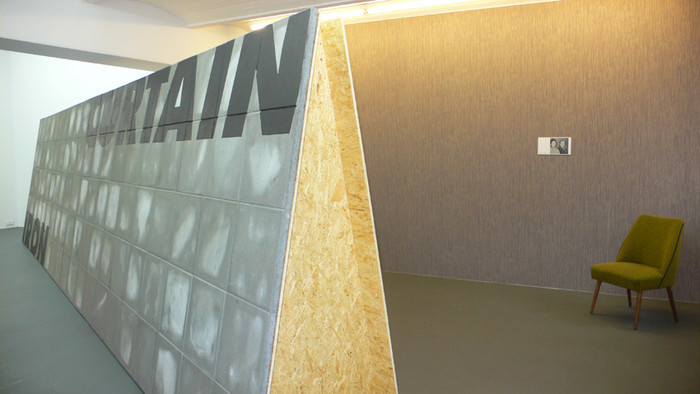TILO SCHULZ: BACK STAGE (IN MEMORY OF JULIUS AND ETHEL ROSENBERG)

Installation shot (c) Tilo Schulz
BACK STAGE (in memory of Julius and Ethel Rosenberg)
“I learned my politics from the Museum of Modern Art.” This quote is attributed to Nelson A. Rockefeller in a biography of the one-time governor of New York and former president of the city’s Museum of Modern Art. The Rockefeller family stands as a unique example of the links between art and politics in twentieth-century America. If one looks at the shows presented at MoMA between 1942 and the early years of the Cold War, as well as the prominence of propagandist themes (e.g., 'Road to Victory' or 'The Family of Man'), the exhibition designs themselves (some of them realized by the German Bauhaus master Herbert Bayer) also offered a suggestive mise-en-scène of political historiography and knowledge production. At this point, if not before, it becomes only too clear that the presentation of art does not consist solely of the object on show in a contemplative space detached from reality. On the contrary, the complex whole comprising the exhibit’s content, form, and context, plus the exhibition venue, transports the combined effects of artistic creativity, institutional program, and conditions within society.
Both the politics of representation in the form of a specific exhibition display, and the constructions and portrayals of the culture of a white, heroic, American masculinity are recurring themes in the site-specific works of Leipzig artist Tilo Schulz. His third solo show “BACK STAGE (in memory of Julius and Ethel Rosenberg)” at Jan Winkelmann / Berlin works directly with the existing conditions of the gallery space: In the back area, the gray-blue wallpaper and a green easy chair in the style of the 1950s suggest a private room of this period. But instead of any sense of security or coziness, the low vaulted brick ceiling and the bars across the windows to the back courtyard create a sense of confinement, unease, and oppression. One is unavoidably reminded of a cell, an impression reinforced by a photograph attached to the wall. The picture shows the Jewish American couple Julius and Ethel Rosenberg in a police truck after the announcement of their sentence in 1951. The Rosenbergs were accused of spying for the Soviet Union on the building of the atom bomb, sentenced to death in a show trial, and executed by electric chair in 1953. This political event exemplifies the hysteria of the Cold War and the anti-communist witch hunt of the McCarthy era.
The separation between private and political is completely abolished by a plywood wall that dominates the space, marking the limit of the abstract living room and acting as an information carrier: like a wall newspaper, it shows pages from Robert Coover’s novel The Public Burning (1977) in poster format. Appeals for clemency are presented in the form of a Dramatic Dialogue by Ethel Rosenberg and Dwight Eisenhower (who became U.S. President in 1953), a fiction documenting a communication-free encounter between the hearing of a demonstrably innocent woman and the personification of the sovereign power of the ideological state apparatus ('Uncle Sam'). Hovering between sculpture and display, the partition wall can also be read as a commercial billboard. On the other side it is covered with regular concrete paving slabs bearing the words IRON and CURTAIN—with its large Futura type, the Cold War slogan now looks like a marketing logo, welcoming visitors as they enter the gallery.
In “BACK STAGE,” the strong narrative structure in the space means that the obvious overlapping of thematic and formal references comes across as less hermetic than in earlier presentations by Tilo Schulz. This show also sees him dealing more strongly with a specific political/historic state by means of a political/aesthetic approach. In this way, Schulz makes a forceful analysis of that which Rockefeller claimed for himself decades earlier from the perspective of a representative of state power—representation by presentation.
Doreen Mende, March 2007
Published in von hundert, April 2007 issue
www.vonhundert.de
Galerie Jan Winkelmann / Berlin, March 10 – April 21, 2007
